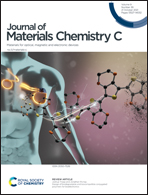A zero-thermal-quenching perovskite-like phosphor with an ultra-narrow-band blue-emission for wide color gamut backlight display applications†
Abstract
Exploring high efficiency narrow-band phosphors is an important enabler for the wide color gamut, high color rendition and visual luminous efficacy of the illumination and display devices. However, rare earth activated narrow-band phosphors are quite rare and the latest progress in this field is mainly limited to the UCr4C4-type prototype structure. Herein, a novel perovskite-like K2BaPO4F:Eu2+ phosphor with an ultra-narrow-band blue-emission is being reported. Due to the large band gap, high lattice rigidity and high symmetry of the host, the K2BaPO4F:1.5%Eu2+ phosphor exhibits an unprecedented ultra-narrow-band (FWHM = 25 nm) blue-emission (λem = 439 nm) and a zero-thermal-quenching property up to a temperature of 125 °C. The K2BaPO4F:1.5%Eu2+ phosphor displays a high color purity (99%) and excellent chromaticity stability in the temperature range from 298 to 523 K. Moreover, the K2BaPO4F:1.5%Eu2+ phosphor has outstanding chemical stability, whose emission intensity can still remain at a high level (91% of that of the pristine sample) after being exposed to ambient atmosphere for 4 months. Depositing the commercial red phosphor K2SiF6:Mn4+, green phosphor β-SiAlON:Eu2+ and as-synthesized blue phosphor K2BaPO4F:1.5%Eu2+ on a 380 nm near-ultraviolet (n-UV) light-emitting diode (LED) chip, the color gamut of prototypical white LEDs can reach 83% of the NTSC (National Television System Committee) area in CIE 1931. These findings not only demonstrate a potential application of the as-synthesized K2BaPO4F:1.5%Eu2+ phosphor in backlight technology, but also shed some new light on exploring unexpected narrow-band phosphors with versatile prototype structures.



 Please wait while we load your content...
Please wait while we load your content...